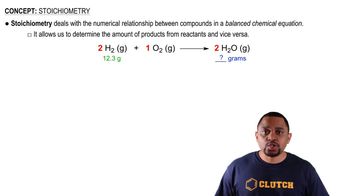Determine the minimum concentration of the precipitating agent on the right to cause precipitation of the cation from the solution on the left. a. 0.035 M Ba(NO3)2; NaF
Ch.17 - Aqueous Ionic Equilibrium
Chapter 17, Problem 107a
A solution is 0.010 M in Ba2+ and 0.020 M in Ca2+. a. If sodium sulfate is used to selectively precipitate one of the cations while leaving the other cation in solution, which cation will precipitate first? What minimum concentration of Na2SO4 will trigger the precipitation of the cation that precipitates first?
 Verified step by step guidance
Verified step by step guidance1
Identify the possible precipitates and their solubility products (Ksp). For this problem, the possible precipitates are BaSO4 and CaSO4. The Ksp values are typically found in a chemistry reference or textbook.
Write the solubility product expressions for each potential precipitate. For BaSO4, the expression is Ksp = [Ba2+][SO42-]. For CaSO4, the expression is Ksp = [Ca2+][SO42-].
Calculate the ion product (Q) for each cation with the initial sulfate concentration from Na2SO4. The ion product Q is calculated using the concentrations of the ions in the solution. For example, Q for BaSO4 is [Ba2+][SO42-] and for CaSO4 is [Ca2+][SO42-].
Compare the ion product (Q) with the solubility product (Ksp) for each compound. Precipitation occurs when Q exceeds Ksp. Determine which cation forms a precipitate first by comparing which Q reaches or exceeds its respective Ksp first as the concentration of sulfate ion increases.
Calculate the minimum concentration of Na2SO4 needed to initiate precipitation for the cation that precipitates first. This can be done by setting up the equation Q = Ksp and solving for [SO42-], then using the stoichiometry of Na2SO4 to find its concentration.

Verified Solution
Video duration:
5mWas this helpful?
Key Concepts
Here are the essential concepts you must grasp in order to answer the question correctly.
Solubility Product Constant (Ksp)
The solubility product constant (Ksp) is a numerical value that represents the equilibrium between a solid and its ions in a saturated solution. It is specific to a particular ionic compound and indicates the extent to which the compound can dissolve. For precipitation to occur, the product of the concentrations of the ions in solution must exceed the Ksp value of the compound formed.
Recommended video:
Guided course

Solubility Product Constant
Selective Precipitation
Selective precipitation is a technique used to separate ions in a solution based on their solubility differences. By adding a reagent that forms a precipitate with one ion while leaving others in solution, it allows for the isolation of specific cations. The order of precipitation is determined by the Ksp values of the potential precipitates, with lower Ksp values precipitating first.
Recommended video:
Guided course

Selective Precipitation
Concentration and Stoichiometry
Concentration refers to the amount of a substance in a given volume of solution, typically expressed in molarity (M). Stoichiometry involves the calculation of reactants and products in chemical reactions based on their molar ratios. In the context of precipitation, understanding the concentration of the sulfate ions from sodium sulfate is crucial to determine the minimum amount needed to initiate the precipitation of a specific cation.
Recommended video:
Guided course

Stoichiometry Concept
Related Practice
Textbook Question
2167
views
1
comments
Textbook Question
Determine the minimum concentration of the precipitating agent on the right to cause precipitation of the cation from the solution on the left. b. 0.085 M CaI2; K2SO4
561
views
Textbook Question
Determine the minimum concentration of the precipitating agent on the right to cause precipitation of the cation from the solution on the left. c. 0.0018 M AgNO3; RbCl
513
views
Textbook Question
A solution is 0.010 M in Ba2+ and 0.020 M in Ca2+. b. What is the remaining concentration of the cation that precipitates first, when the other cation begins to precipitate?
1213
views
Open Question
A solution is 0.022 M in Fe2+ and 0.014 M in Mg2+. a. If potassium carbonate is used to selectively precipitate one of the cations while leaving the other cation in solution, which cation will precipitate first? What minimum concentration of K2CO3 will trigger the precipitation of the cation that precipitates first? b. What is the remaining concentration of the cation that precipitates first when the other cation begins to precipitate?
Textbook Question
A solution is made 1.1⨉10-3 M in Zn(NO3)2 and 0.150 M in NH3. After the solution reaches equilibrium, what concentration of Zn2+(aq) remains?
1060
views
